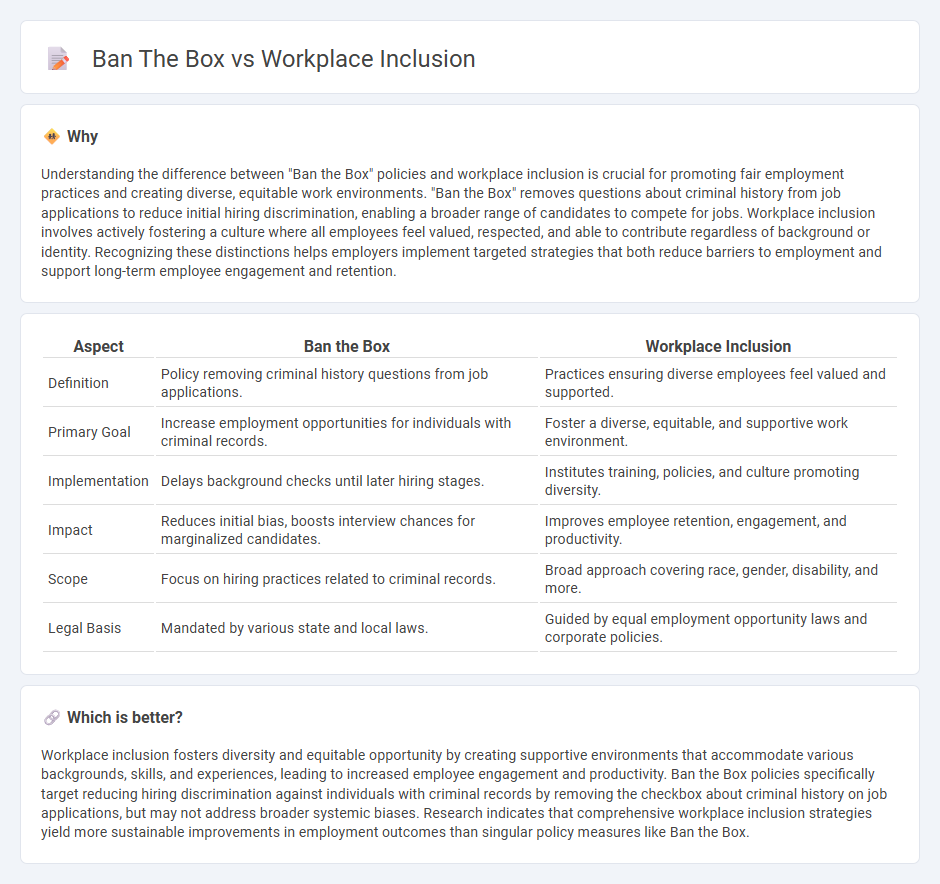
Ban the Box policies remove criminal history questions from initial job applications to reduce employment barriers for ex-offenders, promoting fair hiring practices. Workplace inclusion strategies focus on creating environments where diverse employees, including those with criminal records, feel valued and supported, enhancing overall organizational performance. Explore how combining Ban the Box with inclusive workplace initiatives fosters equitable employment opportunities.
Why it is important
Understanding the difference between "Ban the Box" policies and workplace inclusion is crucial for promoting fair employment practices and creating diverse, equitable work environments. "Ban the Box" removes questions about criminal history from job applications to reduce initial hiring discrimination, enabling a broader range of candidates to compete for jobs. Workplace inclusion involves actively fostering a culture where all employees feel valued, respected, and able to contribute regardless of background or identity. Recognizing these distinctions helps employers implement targeted strategies that both reduce barriers to employment and support long-term employee engagement and retention.
Comparison Table
| Aspect | Ban the Box | Workplace Inclusion |
|---|---|---|
| Definition | Policy removing criminal history questions from job applications. | Practices ensuring diverse employees feel valued and supported. |
| Primary Goal | Increase employment opportunities for individuals with criminal records. | Foster a diverse, equitable, and supportive work environment. |
| Implementation | Delays background checks until later hiring stages. | Institutes training, policies, and culture promoting diversity. |
| Impact | Reduces initial bias, boosts interview chances for marginalized candidates. | Improves employee retention, engagement, and productivity. |
| Scope | Focus on hiring practices related to criminal records. | Broad approach covering race, gender, disability, and more. |
| Legal Basis | Mandated by various state and local laws. | Guided by equal employment opportunity laws and corporate policies. |
Which is better?
Workplace inclusion fosters diversity and equitable opportunity by creating supportive environments that accommodate various backgrounds, skills, and experiences, leading to increased employee engagement and productivity. Ban the Box policies specifically target reducing hiring discrimination against individuals with criminal records by removing the checkbox about criminal history on job applications, but may not address broader systemic biases. Research indicates that comprehensive workplace inclusion strategies yield more sustainable improvements in employment outcomes than singular policy measures like Ban the Box.
Connection
Ban the Box policies enhance workplace inclusion by removing questions about criminal history from initial job applications, reducing bias against formerly incarcerated individuals. This approach promotes equal employment opportunities and diversifies the workforce, fostering a more inclusive environment. Employers adopting these policies often experience increased employee retention and improved community reputation.
Key Terms
Diversity
Workplace inclusion emphasizes creating environments where diverse talents feel valued and empowered, fostering innovation and employee engagement. Ban the Box policies specifically target reducing bias in hiring by removing criminal history questions from initial job applications, promoting fair chances for individuals with records. Explore how integrating both strategies drives comprehensive diversity and equity in your organization.
Fair Hiring Practices
Workplace inclusion emphasizes creating diverse environments where all employees feel valued and respected, enhancing collaboration and innovation. Ban the Box initiatives specifically target fair hiring practices by removing criminal conviction questions from initial job applications to reduce employment barriers for formerly incarcerated individuals. Explore how combining these strategies can drive equitable recruitment and foster truly inclusive workplaces.
Equal Opportunity
Workplace inclusion fosters Equal Opportunity by embracing diverse talents regardless of background, creating fair hiring and advancement practices that reflect individual skills. Ban the Box laws specifically remove criminal history inquiries from initial job applications to prevent bias against candidates with convictions, enhancing chances for reintegration and equal employment. Explore how combining workplace inclusion strategies with ban the box policies drives comprehensive equity in hiring practices.
Source and External Links
Examples of Inclusion in the Workplace - LeaderFactor - Workplace inclusion means creating an environment where all employees feel valued and supported regardless of their background, leading to benefits like increased diversity, better retention, and more innovation, often through practices such as supporting employee resource groups.
Inclusion In The Workplace: What It Means And Its Strength | NU - Inclusion fosters belonging among employees and can be achieved by educating leaders, forming inclusion councils, and celebrating employee differences, which together enhance productivity and innovation.
What Is Inclusion in the Workplace? A Guide for Leaders | CCL - Inclusion involves making employees feel valued and respected by committing to diverse representation, intentional communication, and supportive leadership that addresses bias and promotes collaboration.
 dowidth.com
dowidth.com